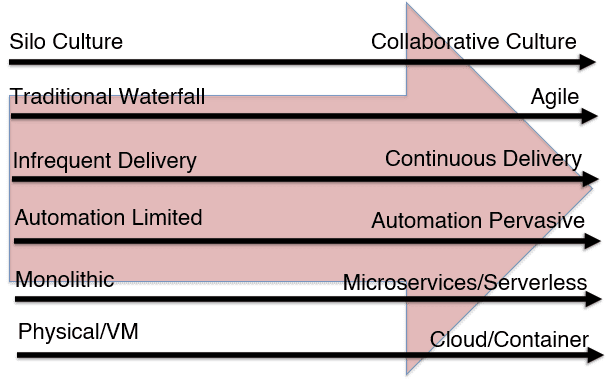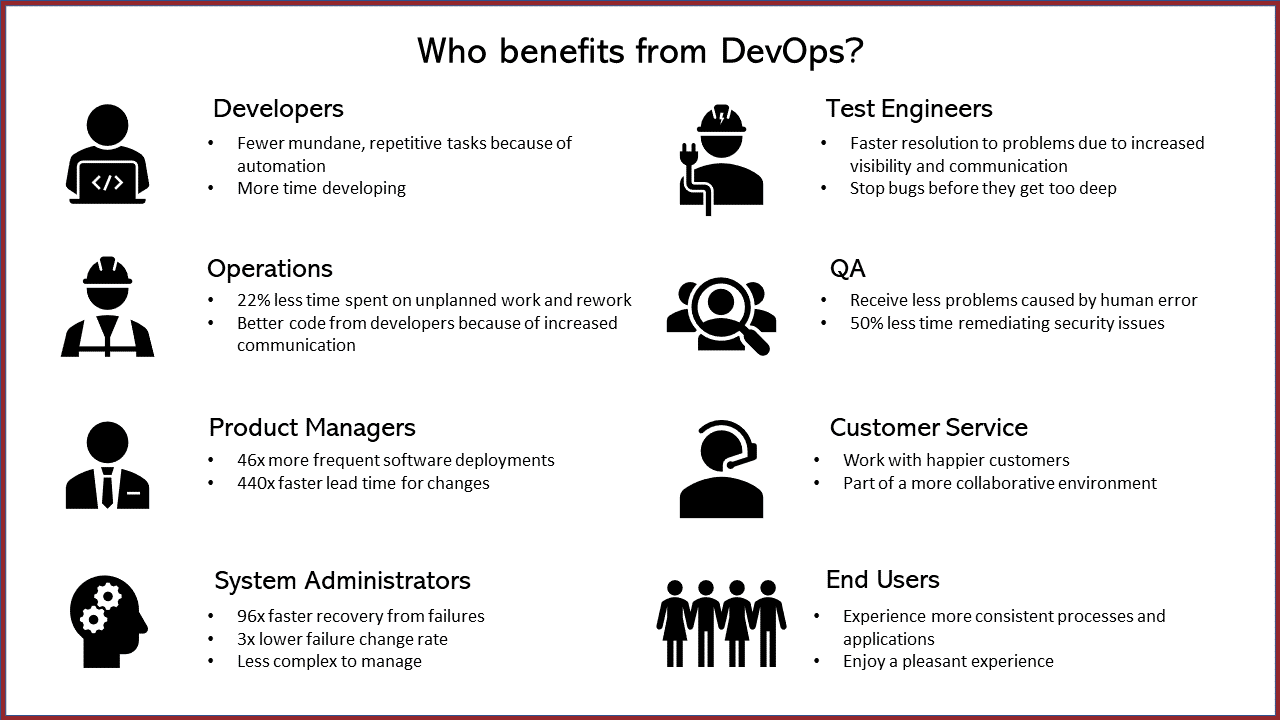Developers grumble:
“I’m doing slow, painfully tedious manual tasks everyday and getting called at all hours. So much needs to get done, but there isn’t enough time in the day.”
Managers complain:
“We have to deliver more and more frequently, and that’s becoming nearly impossible because of collaboration issues and errors resulting from rushed manual tasks.”
And leadership says:
“Engineers are spending too much of their time in code management and deployment processes. That’s wasted time. And, frankly, unacceptable inefficiency. We can’t keep up with the demands of our business at this rate. We need processes that work and minimize costs.”
If you hear this at your organization, you are struggling with the very issues that lead to the inception of DevOps.
Wait!
Don’t leave because you already practice DevOps, or think it’s not for you, or don’t want to hear about this old news “DevOps”.
Yes, the concept of DevOps isn’t always well received. However, many individuals and organizations swear by DevOps and boast a plethora of benefits. There has to be something to that, right?
It’s time to give extensive automation a fair shake.
Exploring Today’s Challenges
The goal of developing and delivering software is to do it in a quick, high-quality, and cost-effective manner. Everyone wants to see the process become faster and more repeatable while simultaneously reducing cost and risk.
Unfortunately, manual tasks impede the process and prevent organizations from reaching this goal.
Manual tasks, handoffs, disjointed communication, and poor visibility slow down developers and engineers and ripple through to QA, managers, directors, and the organization at larger.
These inefficient processes mean long nights in the office babysitting deployments and pushing to get projects delivered on time.
Furthermore, manual inputs open the possibility for human errors, which can result in outages if not caught in time.
HNI Corporation struggled with manual and scripted processes that resulted in errors, lack of visibility, and challenges with reporting. This was both time-consuming and frustrating for the team. The Applications Manager explained, “Each time we saw a release, or an event was bigger than a few objects, we exponentially grew in our risk to be able to do that successfully and do it in a timely fashion.”
How to Solve These Challenges
HNI went on to reduce their deployment time by 60x. Let’s investigate how they achieved these results.
As HNI and other companies have discovered, important factors in software development and delivery success include:
- Security
- Integrated toolchains
- Test and quality automation
- An agile mindset
- A collaborative culture
- Continuous everything: continuous integration, continuous delivery, and continuous deployment
Eliminate Manual Processes and Scripting
Automation is essential to eliminate manual processes and scripting.
Most enterprises are somewhere along their journey to automation, from traditional Waterfall methodology to an Agile mindset, from infrequent delivery to continuous delivery, and more.

Often, the first step is to adopt continuous integration, which is the practice of integrating code from multiple developers into a central location frequently. In fact, estimates report 88% of companies worldwide have implemented some aspects of continuous integration.
(Discover continuous integration best practices here.)
The journey to automation includes continuous delivery, continuous deployment, build automation, deployment automation, test automation, and more. By adopting more and more of these practices, organizations will experience more and more benefits.
Every role at the organization can benefit.
Quite obviously, developers have fewer mundane, repetitive tasks and can spend more time developing. Operations spend less time on unplanned work and rework. QA receive fewer issues caused by human error. Test Engineers can stop bugs sooner and resolve problems faster.
Product managers, system administrators, customer service, and end users also benefit. This article explores how each role benefits and what results you can expect.
The Apps Manager at HNI was amazed and exclaimed, “You’ve got to be kidding me,” when realizing they could have simplified and eliminated these long-lived struggles earlier.
HNI estimates that what one person previously completed in a day can now be finished in 15 minutes after implementing the FlexDeploy DevOps platform.
Moreover, the team significantly cut time from request to delivery significantly and cut off-hours support two hours a night.
Read our report, State of DevOps: Best Practice Adoption to find out.
Gain Visibility into the Pipeline
Running manual processes also means teams have limited visibility into what artifacts are where across the lifecycle, or what deployments have been executed to which environments. Additionally, there is often no visibility into errors that occur post-deployments.
Understanding what artifacts are where and what deployments have been completed to which environments is essential to successful software delivery, but nearly impossible with pervasive manual processes.
HNI experienced these challenges. One result of their the lack of visibility – they had to pull manual reports to validate changes they just deployed.
After adopting FlexDeploy, the HNI team increased visibility into the delivery lifecycle and improved their ability to report on deployment timelines. They have defined releases and are able to execute across a reusable pipeline which has visibility throughout. This gives the team control that they did not previously have.
DevOps increases visibility throughout the entire software development process, allowing teams to detect errors, locate their origins, and discover the cause. Recovery from failures can be as great as 96x faster with DevOps.
Reduce Risk and Errors
Increased visibility leads to faster recovery from failures. More importantly, automation eliminates errors before they occur.
It’s well known that humans cause error, but a well-designed and automated process eliminates these mistakes.
The best way to handles errors is to stop them from occurring in the first place!
You may have heard the argument that automation causes errors. This can be true if automation is left unmanaged and poorly implemented.
However, with best practices, the opposite is true.
Automation eliminates the need for human intervention, therefore eliminating human error. Add continuous delivery to make little changes more frequently so large amounts of code and other changes are not being implemented in one huge bundle. This means any errors that occur can be easily identified and quickly corrected.
For this reason, the risks of software development and deployment are drastically reduced.
HNI enjoyed the reduction of errors after implementing FlexDeploy. The team had more confidence in their releases. Because of this, they didn’t have to babysit their deployments, and they cut their off-hours support by two hours a night.
Faster and Higher Quality Software Development and Delivery
Arguably, the biggest benefit of automation is faster and higher quality software development and delivery.
By developing streamlined and repeatable processes and incorporating end-to-end automation, organizations can experience significantly faster time-to-market.
HNI reduced deployment time by 60x by eliminating manual steps through pipelines that also incorporate scheduling and dependency execution. FlexDeploy was the “whole solution” they were looking for, including continuous integration and continuous delivery features.
The Apps Manager stated, “Thanks to FlexDeploy’s release and pipeline functionality I can let [FlexDeploy] run the show and it’s all the same month over month.”
They benefited from seamless delivery by removing manual tasks, human intervention, and required touch points. They automated everything, including the creation and deployment of artifacts across various environments via pre-set pipelines.
Take the Next Steps
It’s time to experience the benefits of automation, including:
- Faster time-to-market and time-to-feedback
- Improved customer satisfaction
- Increased ability to build the right solution
- Better product quality
- More reliable releases
- Improved productivity
- Decreased cost and risk
- And more
If you’re at an organization that rejects the adoption of automation and/or DevOps, here are 7 arguments you may hear and how you can respond to them.
If you’re ready to jump into DevOps, here’s a guide to find the best DevOps tools for your business.
Want to learn more about FlexDeploy and how you can achieve its benefits?





